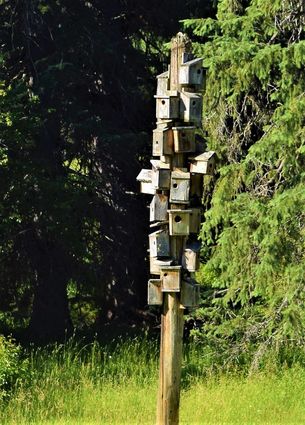Vandals damage nest boxes in Camas Prairie
July 11, 2019

Shana Neesvig
BLUEBIRD NESTING BOXES are a common sight in the area. Bart Granlund of Hot Springs spends his spare time monitoring 70 nesting boxes in Camas Prairie. He reported that 28 boxes were destroyed with a shotgun this last spring.
One of the most recognizable birds in the area, due to its cerulean-blue color, is the mountain bluebird. While driving along roadways, one will observe fence posts supporting homes for these little beauties.
Active mountain blue birder Bart Granlund of Hot Springs has spent the last five years monitoring approximately 70 nest boxes along three blue birding routes located in Camas Prairie. "We record data on nesting activity each nesting season and report the number of successful fledglings, etcetera," Granlund stated.
"At some point in late May or early June, one or more vandals destroyed 28 of the 32 nest boxes on our Wilk's Gulch route with a shotgun," stated Granlund regretfully. Although he is not expecting the wrongdoers to be identified, he hopes to "bring awareness to citizens of Montana about the MBTA and the importance of protecting our fine-feathered friends."
The MBTA (Migratory Bird Treaty Act), one of the earliest adopted wildlife protection laws, was established by the National Audubon Society and first enacted in 1916 to protect not only mountain bluebirds, but other migratory bird species. Granlund, who claims the Act has saved millions of birds, feels that "despite the importance of the conservation movement, many people are still unaware of the MBTA and the types of activities that fall under the law," giving more concern to the vandalized nesting boxes.
Although common now, according to the North American Breeding Bird Survey, mountain bluebird populations declined by roughly 26% between the years 1966 and 2014. The current breeding population is estimated to be a stable 4.6 million and not on the 2014 State of the Birds Watch List.
Nest box construction provides suitable habitat for the birds (who cannot create their own cavities), especially in areas where tree diameters are too small to contain hollows. Although providing nesting boxes does not guarantee bluebirds will move in. Sparrows, wrens and starlings are aggressive competitors for these spaces.
Granlund is a member of the Mountain Bluebird Trails Conservation Society (MBTCS), an organization dedicated to restoring bluebirds in areas they originally thrived in. MBTCS has been active for over 30 years. To receive more information or to volunteer visit bluebirdtrails.org.





Reader Comments(0)